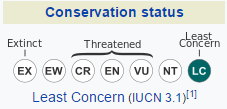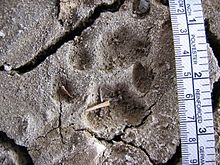Ocelot (Leopardus pardalis )
The ocelot, also known as the dwarf leopard, is a wild cat distributed extensively within South America, including the islands of Trinidad and Margarita, Central America, and Mexico. Ocelots range in color from light yellow to reddish gray, with dark spots and stripes. They have dark stripes on their cheeks and their tailed have rings of dark fur.
Size
- Size: 28 to 35 in (70 to 90 cm)
- Weight: 24 to 35 lbs (11 to 16 kg)
Lifespan
- Up to 20 years in capitivity
- 7-10 years in the wild
Reproduction
- Mating Season: Ocelots may mate at any time of the year, and the time when peaks occur varies geographically.
- Gestation: 79-85 day gestation period
- Litter Size: 1-3
- Kitten Rearing: Kittens are independent after about one year, but may stay with their mother for an additional year.
Range
Diet
Behavior/Habitat
Ocelots are strongly nocturnal, resting in trees or dense brush during the day. Ocelots are very active, traveling from one to five miles per night. Males usually travel further than females. They capture an average of one prey item for every 3.1 hours of travel. It inhabits tropical forest, thorn forest, mangrove swamps and savanna at elevations up to 1,200 m (3,900 ft). It prefers areas with relatively dense vegetation cover, but occasionally also hunts in more open areas at night.

Population/Status
An estimated 800,000 to 1.5 million are found worldwide. In the U.S., just 30 ocelots remain in an isolated population in southeast Texas.

Threats
Habitat loss due to agriculture, hunting for their fur, pet trade. In addition, this animal is sought by poachers in order to market their skin, because of the aesthetic values it has. At the level of America, its main threats are loss and fragmentation of habitat, illegal trade in specimens and skins, hunting and predation retaliation for poultry species. Naturally, Ocelot is predated by jaguar, puma, and harpy eagle boa.
Interesting Facts
The world does not pay for what a person knows. But it pays for what a person does with what he knows.
~Laurence Lee

Primary Sources:
Defenders of Wildlife and Wikipedia






